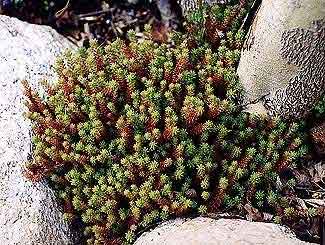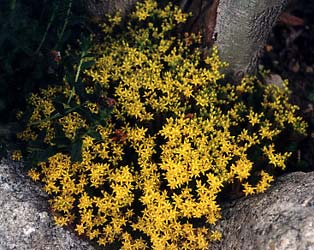
Goldmoss Wall Pepper Stonecrop
"Hurrah for positive science! long live exact demonstration!
Fetch stonecrop, mixt with cedar & branches of lilac."
-Walt Whitman
(1819-1892)
(1819-1892)
Sedum acre var. aurea 'Goldmoss' (sometimes rendered Gold Moss or Golden Moss) is a tiny pale green spreading stonecrop which blooms May & June, when the tiny yellow flowers lend it the appearance of a golden moss.
The scientific name acre alludes to its peppery pungeance if crushed. Several common names for the species allude to the peppery odor & acrid flavor: Wall Pepper, Biting Stonecrop, Prick Madam, Wall Ginger, Mousetail, or Bird's Bread. It's also known as Jack-of-the-Buttery, Golden Carpet, & Gold Chain for its flowers, & has such miscellaneous names as Small Houseleak, Mossy Stonecrop, & Creeping Tom.
Goldmoss Wall Pepper creates a one or two-inch tall spreading mat, half the height of regular S. acre. The species is one of the hardiest of hardy stonecrops, a Eurasian native that grows wild from Great Britain to Russia into western China. There are white as well as yellow flowering races. The variant aurea is the smallest of the commonly gardened sedums, with a slightly slower rate of spread than most sedums.
 Its key threats are poorly draining soil or larger groundcovers. Even other small sedums are comparatively large & can displace it over time. If tucked between rocks where nothing can grow too close around or right over it, it'll be much happier; or it can be used as a potted sedum underneath an airy dwarf shrub that won't shade the Goldmoss overmuch.
Its key threats are poorly draining soil or larger groundcovers. Even other small sedums are comparatively large & can displace it over time. If tucked between rocks where nothing can grow too close around or right over it, it'll be much happier; or it can be used as a potted sedum underneath an airy dwarf shrub that won't shade the Goldmoss overmuch.A peculiarity of so many creeping sedums is they are very bad at climbing upward, but will happily spill over stone ledges or down the sides of planter boxes. If planted in just the right location, it can create a marvelous "spilling" appearance.
Although evergreen, often "semi-evergreen" better describes it, as even in the mild winters of Zone 8 it can partially die back in winter. Like the majority of evergreen sedums, Goldmoss prefers a lot of sunlight, very little water, & rocky soil.
Because it is so small, it can be induced to grow in the narrowest cracks between bricks or stones. It is not treadable, but if placed between raised pavers, it keeps its leaves & flowers low enough to fill in the cracks without climbing up on the pavers where feet would squash it
Ours is placed on a sunlit rockery ledge. In this spot it takes no special care except to make sure no neighboring stonecrops envelop & crowd it out. It will thrive in any zone just so long as it never has to sit in dampness, which will cause it to rot or get dark & homely in the center. Exceedingly well-drained soil is the rule of the day.
All creeping sedums are edible, but Goldmoss is considered very mildly toxic, & may cause stomach upset & wooziness if a great deal of it were eaten. It was nevertheless used in old England, Scotland & Wales as an addition to salads for its "peppery" bite, & I'm confident it was an improvement over blood & kidney pie. If fried it loses even its mild toxicity, & is a good substitute for sweet peppers in home-made relish. In Scandinavian countries S. acre was used for a tea simiilar to lemonaid.
A 1770s Icelandic herbal recommended S. acre (by the name "helluhnori") as a cure for jaundice, gallstones, & respiratory illness. Throughout its extensive range it was used medicinally to treat many serious ailments, such as worms or dropsy. Its alleged values changed from region to region in an unpredictable manner, so whether it treated much of anything successfully seems a longshot. Still, pharmacological studies of S. acre alkaloids have provided some interesting data though without certifying explicit values.